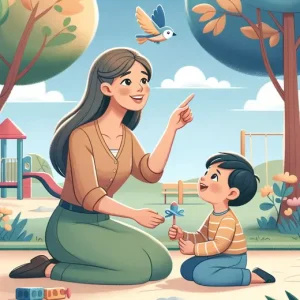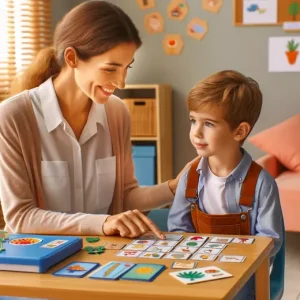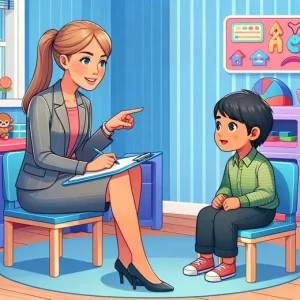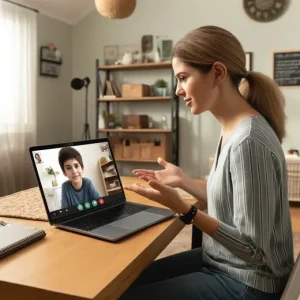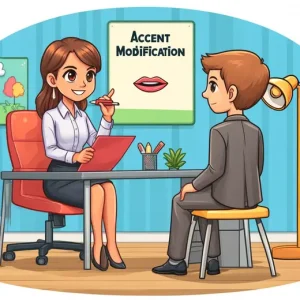Helping Your Child Overcome Stuttering: A Guide
By Rajini D
Last Updated: March 5, 2024
Welcome to a journey where understanding meets action, and care shapes the future of our little ones’ communication. Stuttering is a word that might seem small, but for many preschool children and their families, it represents a world of challenges. It’s where sentences are paused, thoughts are interrupted, and the fluidity of expression seems just out of reach. However, the beauty of early childhood lies in its vast potential for growth and change, making early intervention not just beneficial but crucial.
Stuttering in young children isn’t merely about the repetition of sounds or the visible struggle for words. It’s a unique experience for each child, affecting their interactions, confidence, and even their eagerness to explore the world of words. Recognizing this early on opens a gateway to transformative solutions, paving the way for smoother communication paths.
Understanding Stuttering in Young Children
Imagine being a storyteller with a tale that thrives in your heart, eager to escape, only to find the words lost in a maze of repetitions and pauses. For children experiencing stuttering, this isn’t just an imagination—it’s reality. The impact extends beyond the classroom or playground; it weaves into their social interactions, self-esteem, and even their willingness to participate in everyday conversations.
Also Read: Speech and Language Milestones: 0 to 12 Months
By the Numbers: A Glimpse into Preschool Stuttering
Statistics shed light on the prevalence and nature of stuttering in young children. Did you know that approximately 5% of all children go through a phase of stuttering that lasts six months or more? However, a significant portion of these young speakers—around 75%—will see their stuttering fade away as they grow. Yet, for the remaining 25%, the journey may require intervention to ensure their voices find the smooth pathways of fluent speech.
To understand the basics of stuttering, it’s essential to recognize its nature and impact on children’s lives.
Warning Signs: When to Pay Closer Attention
Identifying stuttering early on can make a substantial difference. Here are a few signs that suggest a child’s stuttering may persist beyond the typical developmental phase:
- Stuttering that intensifies or continues beyond the age of 3 ½ to 4 years.
- A family history of stuttering, indicating a possible genetic link.
- The presence of other speech or language disorders.
- Stuttering that comes with physical tension, facial grimaces, or blinking.
- Reactions of frustration or avoidance of speaking situations by the child.
Recognizing these signs is the first step toward seeking effective stuttering treatment for young children. It’s about offering a hand to those little ones who are finding their way through the maze of words, ensuring they know they’re not walking alone.
Innovative Indirect Therapy Techniques
we delve into the world of indirect therapy techniques—a gentle yet profoundly impactful approach to nurturing fluent speech patterns. Indirect therapy, with its subtle nuances and deep understanding of a child’s environment, offers a comforting hand to those navigating the challenges of stuttering.
The Essence of Indirect Therapy
Indirect therapy stands apart for its focus on altering the child’s environment rather than the child’s speech directly. This method operates on the principle that a supportive, pressure-free environment can significantly reduce stuttering episodes in young children. It’s about creating a space where words can flow more freely without the fear of judgment or the urgency to speak perfectly.
Read more Unlocking Communication: Effective Speech Therapy for Autism
Techniques That Transform
Several innovative techniques fall under the umbrella of indirect therapy, each designed to cultivate a nurturing environment that encourages smooth, unpressured speech:
- Slowing Down: Parents and caregivers are encouraged to model a slower, more deliberate way of speaking. This pace-setting acts as a calm guide for the child, reducing the rush and thereby the stutter.
- Listening Intently: Showing children that they have your full attention makes a world of difference. It signals that what they have to say is important, regardless of how it’s said.
- Reducing Questions: Bombarding a child with questions can increase speaking pressure. Instead, sharing observations encourages them to speak freely, on their terms.
- Commenting and Expanding: Commenting on what the child says and gently expanding on their thoughts offers them a comfortable way to continue the conversation without feeling pressured to speak a certain way.
Direct vs. Indirect Therapy Techniques for Stuttering
| Feature | Direct Therapy Techniques | Indirect Therapy Techniques |
|---|---|---|
| Definition | Involves working directly on stuttering, focusing on changing speech patterns. | Focuses on changing the child’s environment to facilitate fluent speech. |
| Key Techniques | • Speech modification (e.g., slowing down speech, using soft starts) Fluency shaping (e.g., controlled breathing, smooth transitions between words) • Response contingency (praise for fluent speech, gentle correction of stuttered speech) | • Modifying speaking habits of parents/caregivers (e.g., speaking slowly, pausing before speaking) • Reducing communication pressure (e.g., not interrupting, maintaining eye contact) • Enhancing the child’s confidence and communication skills indirectly |
| Age Group | Often recommended for older children who are aware of their stuttering and its impact. | Typically used with younger children who may not be aware of their stuttering or are not yet frustrated by it. |
| Goals | To directly improve fluency through specific speech techniques and strategies. | To create a supportive communication environment that naturally encourages fluency. |
| Role of the Therapist | Active, with structured sessions focusing on speech exercises and monitoring progress. | Advisory, providing guidance to parents/caregivers on creating a supportive environment. |
| Parent/Caregiver Involvement | Engaged in learning and applying direct strategies at home under guidance. | Highly involved in adjusting their communication style and interactions to support fluency. |
| Examples | • The Lidcombe Program • The Camperdown Program | • Parent-child interaction therapy • The Hanen Program |
Direct Therapy Approaches That Work
Direct therapy, in the context of treating stuttering in young children, is akin to meeting the challenge head-on, equipped with a toolkit designed not just to manage but to actively engage and reshape speech patterns.
Understanding Direct Therapy
Direct therapy for stuttering involves structured interventions that directly address the speech disfluencies of children. It’s most appropriate for kids who are already aware of their stuttering and may exhibit frustration or avoidance behaviors related to their speech difficulties. This approach is not about pressuring children to speak ‘perfectly’ but rather providing them with the skills and confidence to communicate effectively, reducing the frequency and severity of stuttering episodes.
Explore key techniques for overcoming stuttering, including direct approaches that have shown promise in young children.
Techniques That Make a Difference
The Lidcombe Program:
A beacon of hope in the direct therapy landscape, the Lidcombe Program stands out for its evidence-based, structured approach. It involves parents or caregivers in the therapeutic process, training them to use positive reinforcement to encourage smooth speech at home. This program has shown remarkable success, especially in younger children, by turning everyday conversations into therapeutic opportunities.
Speech Modeling:
Another cornerstone of direct therapy is speech modeling, where therapists and parents model slow, clear, and fluent speech. This technique allows children to see and hear what fluent speech sounds like, offering them a real-time example to emulate. It’s about showing, not just telling, how to navigate the complexities of communication.
Incorporating Play-Based Therapy:
Recognizing that children learn and engage best through play, direct therapy often incorporates play-based activities. This approach makes therapy sessions feel less like work and more like fun, encouraging children to practice new speech techniques in a low-stress, highly engaging environment. From storytelling to role-playing games, these activities provide a fertile ground for practicing fluent speech in a context that feels natural to the child.
The Essence of Comprehensive Stuttering Therapy
Comprehensive stuttering therapy transcends traditional treatment boundaries by blending the strengths of both direct and indirect methodologies. This approach not only targets the stuttering behavior itself but also the child’s overall communication environment. By addressing the emotional, psychological, and practical aspects of stuttering, comprehensive therapy ensures a more resilient and lasting impact on the child’s ability to communicate with confidence and ease.
Also Read: What is the Relation between Communication, Speech and Language?
Parental Involvement: A Cornerstone of Effective Therapy
The role of parents and caregivers cannot be overstated in the journey toward fluent speech. Education and active involvement of parents in the therapy process are crucial, as they are the child’s primary communication partners. Parental involvement includes training on how to create a supportive speaking environment, how to respond to stuttering, and how to apply direct therapy techniques in daily interactions. This not only empowers parents but also ensures that therapy continues beyond the structured sessions, integrated into the child’s daily life.
Empowering Families, One Word at a Time
The journey through stuttering therapy is a partnership, one that involves therapists, parents, and, most importantly, the child. By embracing a comprehensive approach, Wellness Hub aims to not just address stuttering but to enhance every aspect of the child’s communication skills. Our goal is to build a foundation of confidence, resilience, and joy in communication, ensuring that every child has the opportunity to express themselves freely and fully.
Know more about Understanding & Parenting an Autistic Child: Guide & Tips
Embracing Technology in Stuttering Treatment
The advent of technology has introduced a range of applications and online resources designed to support stuttering treatment. These digital tools offer interactive, engaging platforms for children to practice speech exercises, monitor their progress, and gain confidence in their communication abilities. From apps that facilitate fluency shaping exercises to those that provide real-time feedback on speech patterns, technology offers a personalized approach to stuttering management.
Explore more on our Top 7 Online Speech Therapy Websites in 2024
For parents and caregivers, online resources and platforms provide a wealth of information, tips, and strategies to support their child’s journey towards fluent speech. Webinars, tutorial videos, and online courses offer insights into stuttering and practical advice on enhancing communication within the family and beyond.
The Strength of Support Groups
Support groups for both parents and children who stutter represent a cornerstone of the holistic treatment approach. These groups offer a safe, empathetic space to share experiences, challenges, and successes. For children, interacting with peers who face similar challenges can significantly reduce feelings of isolation and boost self-esteem. For parents, these groups provide a network of support, shared wisdom, and resources that can be invaluable in navigating the complexities of stuttering treatment.
Integrating Technology and Community Support
Incorporating technology and support groups into the stuttering treatment framework offers a comprehensive approach that extends beyond traditional methods. These resources not only enhance the efficacy of direct and indirect therapy techniques but also empower families with knowledge, skills, and a sense of belonging. At Wellness Hub, our commitment is to provide a supportive ecosystem that embraces innovation and community, ensuring every child and family embarks on a journey toward confident communication with the best tools and support by their side.
Engaging Therapy: Beyond the Basics
- Incorporating Play: The essence of childhood is play, and integrating play-based activities into therapy sessions can significantly enhance engagement. Utilizing games, storytelling, and creative arts not only makes sessions more enjoyable but also facilitates natural language development and fluency in a stress-free environment.
- Customizing Therapy Sessions: Recognizing the unique interests and preferences of each child allows therapists to tailor sessions that captivate their attention. Whether it’s incorporating their favorite characters into exercises or using technology and apps that align with their interests, personalized sessions ensure that children are more invested in the therapy process.
- Interactive Techniques: Utilizing interactive techniques such as role-playing, video feedback, and interactive apps engages children actively in their therapy. These methods encourage self-expression and self-monitoring, fostering a sense of autonomy and confidence in their communication abilities.
Effective Strategies for Engaging Young Children in Therapy
| Strategy Name | Description | Application Tips |
|---|---|---|
| Playful Interaction | Utilizing games and play to encourage speech practice. | Choose activities that align with the child’s interests to boost engagement. |
| Visual Aids | Incorporating pictures, videos, and flashcards to illustrate concepts and encourage storytelling. | Use colorful, vivid imagery related to everyday life or the child’s favorites. |
| Reward Systems | Implementing a system of rewards for participation and progress. | Set clear, achievable goals and celebrate success with small rewards. |
| Technology Integration | Using apps and digital tools to make therapy interactive and fun. | Select apps that are age-appropriate and focus on gradual learning. |
| Family Involvement | Engaging family members in therapy sessions to reinforce learning at home. | Encourage siblings to participate in role-playing and practice sessions. |
A Child-Centered Approach
At the heart of our therapy methodology lies the child-centered approach, emphasizing the child’s active participation in their therapy journey. This approach values the child’s voice, choices, and preferences, making them an integral part of the decision-making process regarding their treatment. It fosters a sense of ownership and empowerment, which is crucial for sustained motivation and progress.
Conclusion
In our exploration of innovative techniques for treating stuttering in young children, it’s evident that the journey toward fluent speech is a deeply personal and transformative one. We’ve navigated through the nuanced landscapes of indirect and direct therapy approaches, underscored the vital role of technology and support groups, and highlighted the importance of a tailored, child-centered approach. For parents and caregivers embarking on this journey, remember, personalized support is key. It’s about more than just strategies and sessions; it’s about building a foundation of confidence and communication for your child, step by step, word by word.
Wellness Hub stands as your ally in this journey. With our commitment to providing comprehensive, innovative stuttering treatment solutions, we’re here to support your family at every turn. Our specialized therapists, coupled with our suite of digital resources, offer a holistic approach that is designed to meet the unique needs of your child. At Wellness Hub, we believe in the power of every child’s voice. Together, we can unlock the door to fluent, fearless communication, ensuring that every child has the opportunity to express themselves freely and confidently.
Frequently Asked Questions:
1. What is stuttering in young children?
Stuttering is a common speech disfluency characterized by repetitions, blocks, and prolongations of sounds or syllables. While most children go through a phase of stuttering, for some, it persists beyond the typical developmental phase and may require intervention.
2. What are the signs of stuttering in young children?
Signs to watch for include stuttering that continues beyond age 3-4, family history of stuttering, presence of other speech disorders, physical tension during speech, and the child’s own frustration or avoidance of speaking situations.
3. What are the different types of stuttering therapy?
There are two main approaches:
- Indirect therapy: Focuses on creating a supportive environment that encourages natural, pressure-free speech through techniques like slowing down, attentive listening, and reducing questions.
- Direct therapy: Addresses stuttering directly with structured interventions like the Lidcombe Program, speech modeling, and play-based therapy.
4. What is the best type of therapy for my child?
The best approach depends on your child’s individual needs and age. Consult a speech-language pathologist for a personalized assessment and treatment plan.
5. What is the role of parents in stuttering therapy?
Parental involvement is crucial. Parents are trained to create a supportive environment, respond effectively to stuttering, and implement therapy techniques at home.
6. What are some additional resources for stuttering therapy?
- Technology: Apps, online platforms, and resources offer interactive practice and support.
- Support groups: Connect with other parents and children who stutter for shared experiences and advice.
- Child-centered approach: Therapy should consider the child’s interests and preferences for a more engaging and effective experience.
7. My child is frustrated by their stuttering. What can I do?
It’s natural for children to feel frustrated by stuttering. Acknowledge their feelings, emphasize that stuttering is common, and focus on their strengths as a communicator. Encourage open communication and let them know you’re there to support them. Explore relaxation techniques like deep breathing or meditation to manage frustration.
8. How long does stuttering therapy usually last?
The duration of therapy varies depending on the severity of the stutter, the child’s age, and their response to treatment. Some children see significant improvement in a few months, while others may require longer-term therapy. Consistent practice and following the therapist’s recommendations are crucial for progress.
9. What are some positive outcomes of stuttering therapy?
Stuttering therapy can significantly improve a child’s fluency, reduce their fear of speaking, and boost their confidence and self-esteem. It can also equip them with communication strategies to manage any remaining disfluencies and empower them to express themselves confidently in diverse situations.
10. Are there any risks associated with stuttering therapy?
Stuttering therapy is generally safe and well-tolerated by children. However, it’s crucial to choose a qualified speech-language pathologist with experience treating stuttering. Discuss any concerns you have with the therapist before starting treatment.
About the Author:
Rajini Darugupally
M.Sc., Speech-Language Pathologist (9+ years of experience)
Rajini is a passionate and dedicated Speech-Language Pathologist with over 9+ years of experience, specializing in both developmental speech and language disorders in children and rehabilitation in adults. Driven by a desire to empower each individual to find their voice, Rajini brings a wealth of experience and a warm, genuine approach to therapy.
Currently, at Wellness Hub, she thrives in a team environment that values innovation, compassion, and achieving results for their clients.
Connect with Rajini to learn more about how she can help you or your loved one find their voice.
Book your Free Consultation Today
Parent/Caregiver Info:
Client’s Details:
* Error Message

